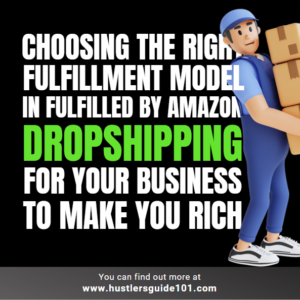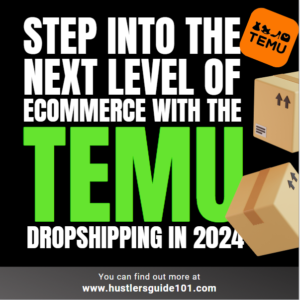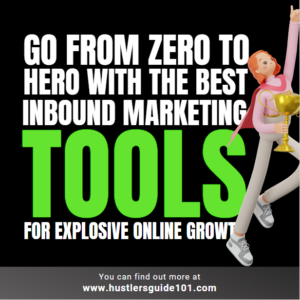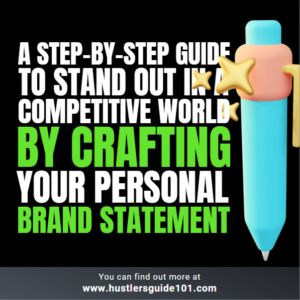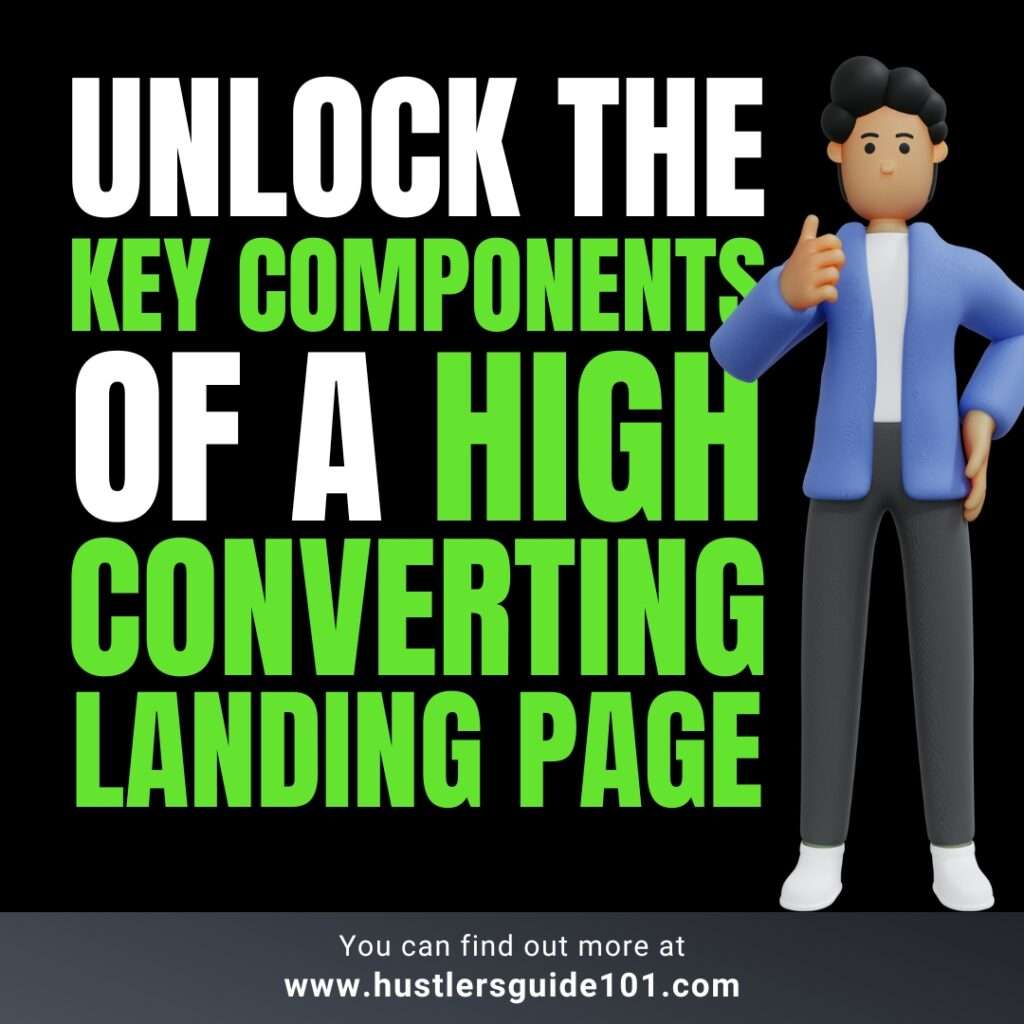
Are you sick of watching potential leads bounce off your pages without a second glance? Maybe it’s time to take a closer look at your landing page. A landing page is a crucial component of any digital marketing strategy, designed to convert visitors into leads or customers. But what are the key components of a landing page that make it effective?
Let’s face it, creating an effective landing page can be overwhelming – where do you start? That’s why I am here to share my insider secrets on how to create a landing page that is sure to get your visitors clicking and converting.
So sit tight and get ready to take some notes – because by the end of this post, you will be armed with all the tools you need to create a landing page that not only looks great but brings in the big bucks.
What are the Key Components of a Landing Page?
Are you ready to learn about the secret ingredients of a high-converting landing page? Great! Because in this section, I am going to take a deep dive into the key components that make up a successful landing page.
Wait! I am not talking about your ordinary, run-of-the-mill landing pages here. I am talking about pages that turn casual visitors into devoted customers.
If you want to go deep into the attributes of a landing page that make a good experience, give it a read here. Let’s jump into the Key Components of a Landing Page.
Headline
The headline of your landing page is arguably the most important component. It’s the first thing visitors will see when they land on your page, and it has the power to make or break their interest in your offer. A strong headline is clear, concise, attention-grabbing, and communicates the value proposition of your offer.
In fact, according to research, 80% of visitors will read your headline, but only 20% will continue reading the rest of the page. This means that your headline needs to capture their attention and communicate the value of your offer in a matter of seconds.
To create a killer headline, start by understanding your audience and what they’re looking for. Use clear and concise language, and consider adding a sense of urgency or scarcity to inspire action.
And don’t be afraid to test and tweak your headlines to find the one that resonates best with your audience. A strong headline can be the difference between a high-converting landing page and a mediocre one.
Subheadline
The subheadline is the second most important component of your landing page, after the headline. While the headline grabs attention and communicates the main benefit of your offer, the subheadline provides additional details and reinforces the value proposition.
The subheadline should be positioned directly under the headline and expand on the main message communicated in the headline. It should be clear, concise, and compelling, providing the visitor with a reason to continue reading and engaging with your offer.
One effective way to create a strong subheadline is to use it to answer the question, “What’s in it for me?” from the visitor’s perspective. This helps to communicate the specific benefits of your offer and persuade the visitor to take action.
Hero Image or Video
The hero image or video is the visual centerpiece of your landing page, and it plays a crucial role in capturing visitors’ attention and creating a strong first impression. This component should be visually stunning and aligned with the message and value proposition communicated in your headline and subheadline.
Research has shown that people process visual information 60,000 times faster than text, making the hero image or video a powerful tool to communicate the value of your offer quickly and effectively.
However, it’s important to choose an image or video that aligns with your brand and message, as a mismatch can create confusion and reduce the effectiveness of your landing page.
In addition to being visually appealing, your hero image or video should also be high-quality and optimized for page load speed. A slow-loading image or video can negatively impact the user experience and increase bounce rates.
Ultimately, the hero image or video should be used strategically to engage visitors and encourage them to explore the rest of your landing page. So, choose wisely and make sure it aligns with your brand, message, and value proposition.
Call-to-Action (CTA)
The call-to-action (CTA) is the element on your landing page that drives the desired action from your visitors, whether that’s making a purchase, filling out a form, or subscribing to a newsletter. It’s a critical component of your landing page because, without it, visitors may leave your page without taking any action.
An effective CTA is clear, concise, and prominently placed on the page. It should stand out visually and use persuasive language to encourage visitors to take action. Creating a sense of urgency and to act quickly can increase the chances of conversions.
Research has shown that using contrasting colors for your CTA button can also increase conversions. By making the button stand out visually from the rest of the page, visitors are more likely to click on it.
Finally, it’s important to ensure that your CTA is consistent with the rest of your landing page messaging and design. If there’s a mismatch between the CTA and the rest of the page, visitors may become confused or mistrustful, reducing the effectiveness of your landing page.
Benefits
The benefits section of your landing page is where you communicate the value and advantages of your product or service to your visitors. This section should clearly outline the benefits that your offer provides, such as saving time, increasing productivity, or improving quality of life.
Effective benefit statements are clear, concise, and focused on the needs of your target audience. By highlighting the specific benefits that your product or service provides, you can create a compelling case for why visitors should take action and engage with your brand.
Research has shown that presenting benefits in bullet points can be an effective way to communicate them quickly and clearly. This format also makes it easier for visitors to scan the page and identify the key advantages of your offer.
When crafting your benefit statements, it’s important to focus on the benefits that are most important to your target audience. By understanding their needs and pain points, you can create a message that resonates and encourages them to take action.
Social Proof
Social proof is a powerful element of your landing page that can help establish credibility and build trust with your visitors. It’s the idea that people are more likely to trust and follow the actions of others, especially if they perceive those individuals as similar to themselves.
There are several different forms of social proof that can be effective on a landing page, including customer reviews, testimonials, case studies, and social media mentions. By including these types of social proof on your page, you can demonstrate the real-world results that others have achieved by using your product or service.
Research has shown that social proof can significantly impact purchasing behavior, with as many as 88% of consumers saying that they trust online reviews as much as personal recommendations. In addition, including social proof on a landing page can increase conversions by up to 20%.
To effectively use social proof on your landing page, it’s important to choose the most relevant and compelling forms of proof for your audience. You should also make sure that the social proof is prominently displayed on the page and presented in a way that’s easy to read and understand.
Trust Indicators
Trust indicators are visual elements on your landing page that help establish your brand’s credibility and trustworthiness. They can include things like security badges, industry certifications, awards, and logos of reputable companies you’ve worked with.
By including trust indicators on your landing page, you can help alleviate any concerns or doubts that visitors may have about engaging with your brand. In fact, research has shown that trust indicators can increase conversion rates by up to 72%.
When choosing trust indicators to include on your landing page, it’s important to select those that are most relevant and meaningful to your target audience. For example, if you’re selling a product that involves sensitive financial information, security badges, and encryption logos may be particularly effective.
It’s also important to display your trust indicators in a prominent and visually appealing way. For example, you may want to create a section of your landing page dedicated to displaying badges and logos, or you may choose to include them strategically throughout the page.
Lead Capture Form
A lead capture form is a key component of your landing page that allows you to collect information from your visitors, such as their names and email address. This information can then be used to follow up with leads, nurture relationships, and ultimately drive conversions.
When designing your lead capture form, it’s important to keep a few key principles in mind. First, the form should be easy to use and require as little information as possible. This will help reduce friction and encourage visitors to complete the form.
Second, you should make sure the form is prominently displayed on your landing page and positioned in a way that’s easy to find. This will help ensure that visitors don’t miss the opportunity to provide their information.
Finally, you may want to consider offering an incentive for visitors to fill out the form, such as a free e-book or a discount on their first purchase. This can help increase the perceived value of the form and encourage more visitors to provide their information.
Research has shown that optimizing your lead capture form can have a significant impact on conversion rates. Forms with just three fields can result in up to a 25% increase in conversions compared to longer forms.
Curious about the cost of creating a high-converting landing page? Check out our guide on landing page costs and start optimizing for success today!
![59 Content Frameworks [50M+ Views & $10M+ sales]](https://hustlersguide101.com/wp-content/uploads/2023/09/ebook-for-blog-1024x535.jpg)
Hot FAQs on what are the key components of a landing page?
What are the features of a good landing page?
A high-converting landing page has several features that make it effective. The page should have a clear headline that communicates the main benefit of the offer, a compelling offer that is relevant to the target audience, and an eye-catching design with high-quality images, contrasting colors and easy-to-read fonts.
Additionally, the landing page should have easy navigation with clear headings, bullet points, and a simple layout, and include social proof like testimonials or reviews to build credibility. Lastly, the page should have a strong call-to-action (CTA) that is clear, concise, and visible on the page.
What are the three types of landing pages?
There are three types of landing pages: click-through landing pages, lead-generation landing pages, and product detail landing pages. Each serves a specific purpose, such as warming up visitors and encouraging them to click through, collecting visitor information, or providing detailed information about a product or service.
What are the objectives of a landing page?
The primary objective of a landing page is to convert visitors into leads or customers, but it can also build brand awareness, collect customer information, and increase sales. A relevant and visually appealing image is an essential component of a landing page. The image should be related to the offer, high-quality, attention-grabbing, visually appealing to the target audience, and support the overall branding.
What should your landing page image include?
The landing page image is a crucial component of a high-converting landing page. It should be carefully selected and optimized to support the overall branding and messaging. An effective landing page image should be relevant to the offer, high-quality, attention-grabbing, visually appealing to the target audience, and support the overall branding.
The image should also be optimized for fast loading times to prevent visitors from leaving the page due to slow loading times. Additionally, the image should be accompanied by relevant and clear captions, alt tags, and descriptions to ensure accessibility and improve search engine optimization.
Ready to take your landing pages to the next level? Don’t miss our essential guide to the do’s and don’ts of creating high-converting landing pages.
Also read: How to create a landing page on Squarespace?
Wrapping up
You did it! You’ve learned all about what are the key components of a landing page and how to create a page that converts like crazy.
But before we go, I have got one last secret tip for you: always be testing! Don’t be afraid to experiment with different elements on your landing page to see what works best for your audience.
With some trial and error, you will be able to create a landing page that is perfectly tailored to your customers’ needs and drives results.
So go forth and create a landing page that wows – I can’t wait to see what you come up with!
Also read: How to create a landing page on Shopify in 4 simple steps?


